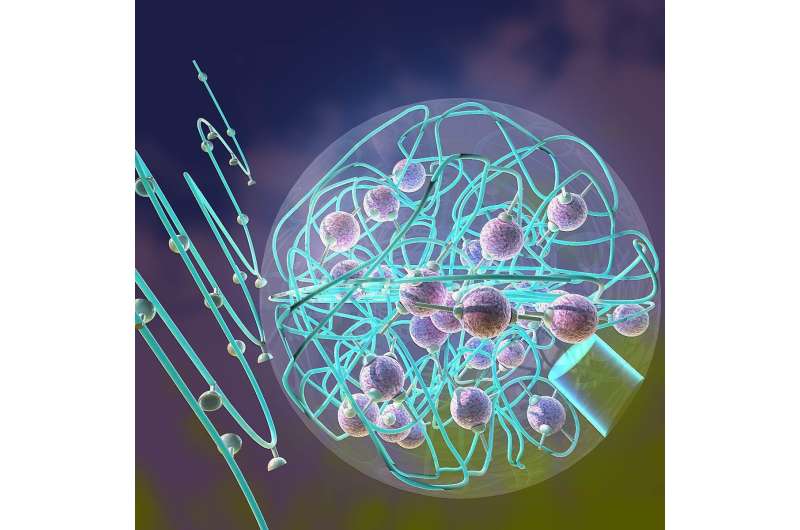Scientists of KIT and QUT in Brisbane/Australia have developed bioinspired, catalytically active single-chain nanoparticles. Credit: Ella Maru
Catalysis, in the course of which a substance accelerates a chemical reaction, but remains unchanged, is of central importance to many industrial processes. To develop efficient catalysts optimized for various applications, researchers of different disciplines working in the Collaborative Research Center "Molecular Structuring of Soft Matter" (CRC 1176) of KIT were inspired by biological models. The chemists combined the structuring of natural enzymes with the design of synthetic macromolecules.
As reported by the scientists in the Journal of the American Chemical Society, their work is inspired by the structure of metallo-enzymes, catalytically active proteins containing a metal. They specifically insert metal ions into a tailored-made polymer framework. The results are catalytically active single-chain nanoparticles. "In first studies, these new multi-functional nanoreactors reached very promising results as regards both catalyst characteristics and product formation," say Professor Christopher Barner-Kowollik, Head of the Macromolecular Architectures Group of the Institute for Chemical Technology and Polymer Chemistry (ITCP), and Professor Peter Roesky, Head of the Chair for Inorganic Functional Materials of KIT's Institute for Inorganic Chemistry (AOC).
The catalytically active single-chain nanoparticles have been developed by the KIT-coordinated collaborative research center "Molecular Structuring of Soft Matter" (CRC 1176) funded by the German Research Foundation (DFG) in close cooperation with Queensland University of Technology (QUT) in Brisbane/Australia. Within this collaborative research center, scientists are working on theoretical, analytical, and synthetic processes to specifically adjust the chain length or sequence of the building blocks of large molecules, for instance. The goal is the controlled structuring of soft matter on the molecular level in three dimensions in order to obtain macromolecules precisely designed for defined functions.
Chemical Passwords and Molecular Tissues
Within CRC 1176, KIT researchers also found a way to reliably protect digitally transmitted sensitive information. They combined computer science and chemistry knowledge, i.e. a common encryption process and a chemical password. It represents a chemical compound with a certain sequence of building blocks and attached side chains. Letters and numbers are assigned to the chemical components.
Another highlight of CRC 1176 are two-dimensional fabrics made of monomolecular polymer threads. To produce these tissues of a single molecular layer in thickness, the researchers used surface-mounted metal-organic frameworks, called SURMOFs, as "looms." The polymer threads are kept together by the chemical forces resulting from the weaving pattern, such that the molecular tissues are as flexible as conventional fabrics.
More information: Hannah Rothfuss et al. Single-Chain Nanoparticles as Catalytic Nanoreactors, Journal of the American Chemical Society (2018). DOI: 10.1021/jacs.8b02135
Journal information: Journal of the American Chemical Society
Provided by Karlsruhe Institute of Technology
























